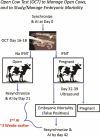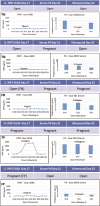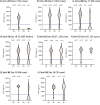Early identification of bovine pregnancy status and embryonic mortality†
- PMID: 40155196
- PMCID: PMC12078079
- DOI: 10.1093/biolre/ioaf066
Early identification of bovine pregnancy status and embryonic mortality†
Abstract
Bovine interferon-tau (bIFNT) is produced by the trophectoderm cells in the bovine conceptus as early as Day 12 following fertilization. It was hypothesized that IFNT detection in blood, milk, and/or cervical secretions could be used to diagnose pregnancy in lactating cows. Recombinant bovine (rb) IFNT was generated to produce goat and rabbit anti-rbIFNT polyclonal antibodies, and an enzyme-linked immunosorbent assay (ELISA) was developed for bIFNT using these reagents. The IFNT ELISA did not cross-react with other type I or II IFNs and had a limit of detection of 50-100 pg/ml. The IFNT ELISA detected IFNT in external ostium (os) cervical swabs from Days 15 to 25 post-AI, but did not detect IFNT in serum, plasma, or milk. The time for most accurately detecting IFNT in cervical fluid was Days 16-19 after AI. A custom bovine swab device used to collect cervical secretions reduced false-negative rates to 5.5% (94.5% sensitivity) in dairy cows on Day 17 and 0% to 3.4% (100% and 96.6% sensitivity) in beef cows on Days 18 or 16, respectively. In summary, the detection of IFNT in cervical fluid by ELISA provides an accurate indication of pregnancy status in lactating dairy cows. Early identification of the non-pregnant cow allows re-insemination on Day 21 compared to waiting until ultrasound (US) on Day ~32-39. In addition, the detection of IFNT on Day 17 followed by the loss of pregnancy detected by US on Day 32 provides a novel research tool for studying pregnancy loss caused by embryonic mortality.
Keywords: bovine; conceptus; diagnostic; interferon-tau; pregnancy.
© The Author(s) 2025. Published by Oxford University Press behalf of Society for the Study of Reproduction.
Figures






Similar articles
-
Application of an ELISA Milk Pregnancy Test in Beef Cows.Reprod Domest Anim. 2015 Aug;50(4):651-8. doi: 10.1111/rda.12546. Epub 2015 Jun 8. Reprod Domest Anim. 2015. PMID: 26058919
-
Establishment of an ELISA for measuring bovine pregnancy-associated glycoprotein in serum or milk and its application for early pregnancy detection.Reprod Domest Anim. 2010 Feb;45(1):142-6. doi: 10.1111/j.1439-0531.2008.01287.x. Epub 2008 Nov 20. Reprod Domest Anim. 2010. PMID: 19032429
-
Evaluation of interferon-stimulated genes in peripheral blood granulocytes as sensitive responders to bovine early conceptus signals.Vet J. 2017 Nov;229:37-44. doi: 10.1016/j.tvjl.2017.10.007. Epub 2017 Oct 19. Vet J. 2017. PMID: 29183572
-
The Importance of Interferon-Tau in the Diagnosis of Pregnancy.Biomed Res Int. 2021 Sep 2;2021:9915814. doi: 10.1155/2021/9915814. eCollection 2021. Biomed Res Int. 2021. PMID: 34513997 Free PMC article. Review.
-
Control of interferon-tau expression during early pregnancy in ruminants.Am J Reprod Immunol. 2009 Feb;61(2):95-106. doi: 10.1111/j.1600-0897.2008.00673.x. Am J Reprod Immunol. 2009. PMID: 19143673 Review.
References
-
- Fricke PM, Wiltbank MC. Symposium review: the implications of spontaneous versus synchronized ovulations on the reproductive performance of lactating dairy cows. J Dairy Sci 2022; 105:4679–4689. - PubMed
-
- Curran S, Pierson RA, Ginther OJ. Ultrasonographic appearance of the bovine conceptus from days 20 through 60. J Am Vet Med Assoc 1986; 189:1295–1302. - PubMed
-
- Pursley JR, Silcox RW, Wiltbank MC. Effect of time of artificial insemination on pregnancy rates, calving rates, pregnancy loss, and gender ratio after synchronization of ovulation in lactating dairy cows. J Dairy Sci 1998; 81:2139–2144. - PubMed
-
- Ball L. Pregnancy Diagnosis in the cow. Philiadelphia: WB Saunders CO; 1980.
-
- Vaillancourt D, Bierschwal CJ, Ogwu D, Elmore RG, Martin CE, Sharp AJ, Youngquist RS. Correlation between pregnancy diagnosis by membrane slip and embryonic mortality. J Am Vet Med Assoc 1979; 175:466–468. - PubMed
MeSH terms
Substances
LinkOut - more resources
Full Text Sources

